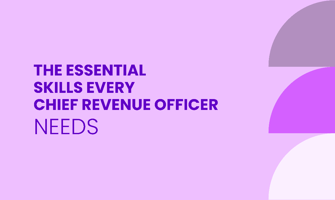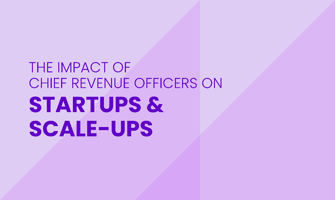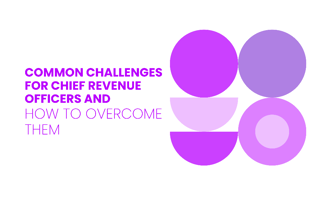The role of a Chief Revenue Officer (CRO) requires a comprehensive understanding of all business...
Strategies Chief Revenue Officers Use to Drive Revenue Growth
Chief Revenue Officers (CROs) employ a multifaceted approach to ensure sustainable growth and resilience in competitive markets. They use various strategies to boost sales, improve customer relationships, and ultimately drive revenue growth.
The article will examine how CROs harmonize strategy, technology, and customer-centricity to achieve long-term commercial success. This includes analyzing data-driven insights, utilizing advanced technologies, fostering collaboration, and promoting continuous improvement for optimal revenue outcomes.
Why CROs are Vital for Revenue Growth
Chief Revenue Officers play an important role in driving a company's revenue growth through strategic and operational excellence.
Align Sales, Marketing, and Customer Success: Ensuring seamless collaboration across all revenue-generating departments.
Set Go-to-Market Strategies: Developing and implementing strategies to meet market demands and drive revenue.
Leverage Data Insights: Using data analytics to make informed decisions and identify growth opportunities.
Enhance Customer Experience: Improving the customer journey to increase satisfaction and loyalty, leading to higher revenue.
Key Strategies for Driving Revenue Growth
1. Data-Driven Decision Making
Data-driven decision-making involves using data analysis and interpretation to guide business decisions. Chief Revenue Officers (CROs) rely on data to understand market trends, predict customer behavior, and optimize operations for revenue growth.
By utilizing data, CROs can make more informed decisions that align with real-time insights. This approach ensures that strategies are based on factual information rather than intuition, leading to more effective and efficient business outcomes.
Benefits
Improved targeting of sales and marketing efforts: By analyzing customer data, CROs can identify the most promising market segments and tailor their sales and marketing strategies to target these groups more effectively.
Accurate revenue forecasting: Data analysis helps in creating precise revenue forecasts by identifying trends and patterns, allowing CROs to make informed decisions and plan for future growth.
Practical Implementation
Invest in analytics platforms: Adopt tools such as business intelligence software and data visualization tools. These tools handle large volumes of data and provide deep insights into market trends and customer behavior, enabling CROs to make informed decisions based on comprehensive data analysis.
Promote data literacy: Ensure all team members understand how to interpret and use data through training programs and workshops. This fosters a data-driven culture where employees at all levels can contribute to data analysis and decision-making.
Automate data collection and analysis: Implement automated systems like data management software and machine learning algorithms for data collection and analysis. Automation saves time, reduces human error, and ensures that data is processed in real-time, providing up-to-date insights.
Integrate data sources: Combine data from different departments such as sales, marketing, and customer service using data integration tools. This provides a unified view of the business, enabling more comprehensive analysis and better-informed decision-making. Tools like 180ops provide comprehensive solutions for managing and integrating data efficiently to drive revenue growth.
![]()
2. Leveraging AI and Technology
Leveraging AI and technology involves using artificial intelligence and advanced technological tools to enhance business processes. CROs use these tools to manage customer engagements, forecast sales, and identify growth opportunities.
These tools enable more efficient operations and deeper insights into customer behaviors, driving strategic decision-making.
Benefits
Increased efficiency through automation: AI and automation tools can handle repetitive tasks, freeing up human resources for more strategic activities and improving overall efficiency.
More personalized customer interactions: AI-driven insights allow companies to understand individual customer preferences and behaviors, enabling them to offer personalized experiences that enhance customer satisfaction and loyalty.
Practical Implementation
Integrate AI in sales and marketing processes: Use AI tools like customer relationship management (CRM) systems and marketing automation software. CRM systems manage customer interactions, helping to identify potential leads, predict customer needs, and personalize marketing campaigns, which increases conversion rates and customer satisfaction.
Adopt advanced software for revenue management: Implement revenue management software that streamlines operations such as billing, invoicing, and financial reporting. These systems improve accuracy, reduce manual errors, and provide real-time financial insights.
Automate routine tasks: Use robotic process automation (RPA) and other automation technologies for tasks such as data entry, report generation, and customer follow-ups. RPA uses software robots to automate repetitive, rule-based tasks, allowing staff to focus on strategic planning and high-value activities, enhancing overall productivity.
Employ predictive analytics: Use predictive analytics tools to analyze historical data and forecast future trends. Techniques such as regression analysis, which predicts future trends based on historical data, and machine learning models, which improve prediction accuracy over time, help CROs anticipate market changes and make proactive, informed decisions that align with the company’s growth objectives.
3. Aligning Sales and Marketing
Aligning sales and marketing involves creating synergy between these traditionally separate departments. Chief Revenue Officers (CROs) play an important role in bridging the gap between sales and marketing, fostering collaboration, and ensuring shared objectives to enhance overall business performance.
By synchronizing these teams, CROs can ensure that marketing strategies effectively support sales efforts, leading to a more cohesive and efficient approach. This alignment helps in delivering consistent messaging and a seamless customer experience, ultimately driving revenue growth
Benefits
Consistent messaging across platforms: Ensures that all customer touchpoints convey the same message, building a strong, unified brand presence.
Efficient lead management: Streamlines the process of converting leads into customers by ensuring that marketing efforts directly support the sales pipeline.
Practical Implementation
Establish clear communication channels: Use collaboration tools like team messaging apps and project management software to facilitate seamless communication between sales and marketing teams. Regular updates and shared dashboards can keep everyone informed and aligned.
Set common goals and metrics: Define shared objectives and performance indicators that both teams work towards, such as lead conversion rates and customer acquisition costs. This alignment helps in measuring success consistently across departments.
Regular cross-departmental meetings: Schedule frequent meetings to discuss progress, share insights, and adjust strategies as needed. These meetings encourage transparency and collaboration, allowing teams to address any misalignments promptly.
Utilize shared workspaces: Implement platforms that allow both teams to access and contribute to the same data, such as shared CRM systems and integrated marketing automation tools. This ensures that marketing campaigns are designed with sales input and that sales teams are aware of ongoing marketing efforts.
Develop integrated campaigns: Coordinate marketing campaigns with sales initiatives to ensure a unified approach. This involves aligning campaign themes, timing, and objectives with sales goals.
![]()
4. Customer-Centric Strategies
Customer-centric strategies focus on placing the customer at the center of all business initiatives. Chief Revenue Officers (CROs) understand the importance of this approach, ensuring that strategies resonate with the target audience to enhance customer satisfaction and loyalty.
By prioritizing the customer's needs and preferences, CROs can create more personalized and effective marketing and sales strategies. This approach not only improves customer satisfaction but also drives repeat business and referrals, which are essential for long-term revenue growth.
Benefits
Stronger customer relationships: Builds trust and loyalty by consistently meeting customer needs and expectations.
Improved customer experience: Enhances every interaction a customer has with the company, leading to higher satisfaction and more referrals.
Practical Implementation
Identify key touchpoints: Use customer journey mapping tools, such as journey mapping software, to map out the entire customer journey and identify key touchpoints like initial contact, purchase decision, and post-purchase support. Understanding these stages helps in designing interactions that meet customer needs effectively.
Utilize CRM systems: Implement Customer Relationship Management (CRM) tools to gather and analyze customer data. CRM systems help create detailed customer profiles and tailor interactions to individual preferences and behaviors, enhancing the customer experience.
Integrate customer success into the business cycle: Ensure that customer feedback and needs are incorporated into product development, sales processes, and service improvements. Achieve this through regular customer surveys, feedback loops, and customer success teams dedicated to addressing client needs and ensuring customer satisfaction.
Tailor the sales process: Use insights from customer data to customize the sales approach. This might include personalized communication, targeted offers, and customized solutions that address specific customer pain points, making the sales process more effective and customer-focused.
Implement loyalty programs: Develop programs that reward repeat customers and incentivize referrals. This can include discounts, exclusive offers, and other benefits that encourage ongoing engagement and build long-term customer loyalty.
5. Pricing Optimization
Pricing optimization involves setting prices to balance market demand, competitive pricing, and the value offered to customers. Chief Revenue Officers (CROs) use this strategy to maximize revenue and maintain customer satisfaction.
By carefully analyzing these factors, CROs can develop pricing strategies that maximize revenue while maintaining customer satisfaction. This approach helps companies remain competitive and profitable in a dynamic market environment.
Benefits
Improved sales margins: Optimized pricing can increase profit margins by finding the ideal price point that maximizes revenue without deterring customers.
Better market positioning: Competitive pricing strategies help position the company favorably in the market, attracting more customers and enhancing brand perception.
Practical Implementation
Market analysis: Use tools like market analysis software and pricing analytics to understand pricing trends, customer preferences, and competitor pricing. These tools gather data from various sources, analyze market dynamics, and provide actionable insights, helping CROs set competitive and appealing prices.
A/B testing: A method to compare two versions to see which performs better. Implement A/B testing to experiment with different price points and determine which prices yield the best results. This iterative approach helps refine pricing strategies over time.
Dynamic pricing models: A strategy where prices are adjusted in real-time based on market demand, inventory levels, and other factors. This allows for more flexible and responsive pricing strategies, ensuring prices remain optimal as market conditions change.
Customer feedback: Gather and analyze customer feedback to understand their price sensitivity and willingness to pay. This information is crucial for setting prices that meet customer expectations and improve customer satisfaction.
6. Building a High-Performance Sales Culture
A high-performance sales culture is essential for driving revenue growth. By instilling values of excellence, accountability, and continuous learning, CROs aim to elevate their teams' performance and, by extension, the company's revenue.
This culture encourages sales teams to exceed targets and continuously improve their skills, leading to higher productivity and better customer relationships.
Benefits
Enhanced motivation and growth: A positive sales culture encourages team members to strive for excellence and pursue personal and professional growth.
Increased sales productivity: Well-trained and motivated sales teams are more efficient and effective, leading to higher conversion rates and better customer relationships.
Practical Implementation
Comprehensive training programs: Develop and implement training programs focusing on product knowledge, sales techniques, and customer engagement. Regular training ensures that sales teams are equipped with the skills they need to succeed.
Performance-based incentives: Introduce incentive programs that reward high performers with bonuses, promotions, and other rewards. This motivates sales teams to achieve and exceed their targets.
Continuous feedback and improvement: Implement a system for continuous feedback, like 360-degree feedback, which involves evaluations from peers, subordinates, and supervisors. This comprehensive feedback helps sales teams identify areas for improvement and develop their skills further.
![]()
Conclusion
CROs implement strategies that drive revenue growth by leveraging data and technology, fostering a culture of continuous improvement, and aligning sales and marketing efforts. These approaches are essential for navigating modern business complexities and achieving tangible results.
As businesses adapt to new technologies and changing customer needs, the role of the CRO will become even more important. These strategies form the backbone of a scalable, agile, and responsive business model.
The insights shared in this blog aim to guide you to understand and adopt the successful practices of top-tier CROs. Focusing on excellence, adaptability, and a customer-centric approach will continue to drive business success.
FAQs
What skills and qualifications are required for a CRO role?
A Chief Revenue Officer (CRO) must possess a diverse set of skills, including strong leadership, strategic thinking, and expertise in revenue operations. Key qualifications often include an MBA or equivalent degree and executive education programs. Experience in leading growth companies and a proven track record in revenue generation are also essential. CROs need to be adept at managing the go-to-market process and working with the executive team to drive scalable revenue models.
What are the main responsibilities and objectives of a CRO?
The main responsibilities of a CRO include overseeing revenue operations, developing scalable revenue models, and leading the sales and marketing teams. Their objectives are to drive revenue growth, enhance customer centricity, and improve process efficiency. CROs play a pivotal role in aligning sales and marketing strategies, managing the end-to-end revenue cycle, and ensuring the company meets its revenue targets.
How do CROs contribute to process improvement in start-ups and growth companies?
CROs are integral to process improvement in start-ups and growth companies. They implement continuous process improvement strategies to optimize the upper and lower funnel activities. By leveraging technology ecosystems, such as Salesforce Revenue Cloud, CROs enhance the efficiency of revenue operations and ensure agility in a competitive market. Their leadership in these areas helps companies achieve hyper-growth and maintain a competitive edge.
Can you provide a sample job description template for a CRO position?
A sample job description template for a CRO position might include:
Title: Chief Revenue Officer (CRO)
Responsibilities: Oversee revenue operations, drive revenue generation, lead the sales and marketing teams, and manage the go-to-market process.
Qualifications: MBA or equivalent, executive education programs, extensive experience in revenue generation, and proven leadership in growth companies.
Skills: Strategic thinking, leadership, customer-centric approach, and proficiency in using digital tools and technology ecosystems.
How do CROs collaborate with other C-suite executives and teams?
CROs frequently collaborate with other C-suite executives, such as the VP of Sales and the executive team, to align revenue strategies and objectives. They work closely with leaders across departments to foster partnerships and community engagement, ensuring a unified approach to revenue generation. This collaboration helps in maintaining a seamless end-to-end revenue cycle and adapting to market changes with agility.
What is the importance of travel insurance for CROs?
While travel insurance is not directly related to the CRO role, it is essential for any executive who frequently travels for business. Travel insurance ensures that CROs are protected against unforeseen circumstances during business trips, allowing them to focus on their responsibilities and objectives without worry.




